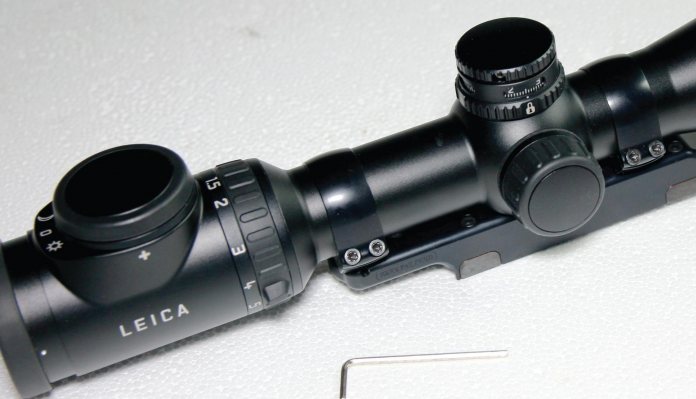Scope Test Leica Magnus 1.5-10x42 BDC
- By Pete Moore
-
0
 Comments
Comments
- Last updated: 07/12/2016

You’d have to be living under a rock for the past four years not to have heard about the litigation issues between Swarovski and Leica over their Magnus scope. I staid well out of it and put off looking at the Magnus until the votes were in. Well it seems they are as the European Patent Court ruled for Leica, so let’s move on!
To me, and I imagine many other shooters, Leica means binoculars and laser rangefinders, but they have for some time offered a small range of telescopic sights. To be honest and though asking until I was blue in the face they never seemed that bothered in sending me anything. Now distributed by Edgar Brothers I have finally got my hands on a Magnus 1.5-10 x 42 with BDC (bullet drop compensation) elevation turret. Also available are a 1-6.3 x 24mm driven/dangerous game model, the 1.8-12 x 50 (universal) and the long range hunter of the group the 2.4-16 x 56mm. All models have an extended zoom range of x6.7, which offers optics with highly flexible magnification runs so allowing multiple usage.
For me the 1.5-10 x 42 is a good all-rounder as you might imagine – down at x1.5 for close and driven work and up at x10 for longer distances and easily capable out to 400m on deer-sized targets. The 1.8-12 x 50 is also attractive for similar reasons with the extra x2 mag and wider objective probably better suited to the British shooter!
The scope is of conventional build with a one-piece, 30mm body tube, all models are illuminated with a slightly familiar rheostat design! The control is a round, rubber pressure pad with OFF in the middle move it right (sun symbol) and its on full power, move it left (moon) and it’s for low light. Brightness is controlled by pushing down on the edge of the drum right side + and left -. Plus it will automatically switch off if the rifle is canted over at 90° or angled vertically. The battery compartment lives under the drum and takes the standard, coin-type cell (included).
Glass quality is brilliant as you might expect with a quoted 91% light transmission, not as high as the 95% of the Zeiss Victory HT but I’m not complaining! Leica use an external, water repellent coating called Aquas Dura, which also works well. As standard turrets offer 1cm clicks @ 100m with a generous 100-clicks per rotation with 2.75 turns available. These are further sub-divided in 5 and 10 cm divisions and dialling in corrections is positive. A large slot head screw allows them to be set to 0 and windage offers 0-50 in both directions.
However I had the BDC version which is a little different. The elevation turret is lockable by a rotary collar with closed and open padlock symbols indicating the status. The drum above has an observation window where you can see the moving dial as you rotate it against a fixed reference stadia. Like both the Zeiss and Swarovski BDC systems the Magnus only offers slightly less than a single turn of correction once zeroed, well in this case 93 cms. This is done to give a ‘zero stop’ position and is achieved by a fixed stop pin in the base of the turret that contacts another in the roof of the moving upper drum.
If your zero requires you to adjust more than a single turn then the turret has to be removed – two Allan grub screws in the rim are unscrewed (Allan key supplied) and it’s lifted up and over the fixed stop pin to gain another rotation. Leica does not explain this very well, though alludes to the fact that it’s possible to run out of elevation, as it is with any other scope of this type. Their solution is to fit angled mounts; all well and good if they are available for your rifle, which with more specialised makes might not be the case!
I fitted the Magnus to my Blaser R8 Professional Success chambered in 270 Winchester and did not have any problems with running out of elevation. I’m not a big fan of BDC turrets on hunting scopes preferring to use eyeball holdover; but when the range is near maximum and providing you have zeroed correctly they do allow time for a more considered shot! On that point the turret movement is firm and easy to count so dialling in is not an issue.
For the BDC model Leica uses the simple Leica-Plex pretty much a Dual-X type with only the centre dot illuminated, other options are also available given the model. Something I thought a bit cheeky was the Direct Dial Rings, which will replace the standard 1cm @ 100m notation elevation ring. It’s very similar to what Zeiss does with their ASV turret where you can go onto their ballistic resource, load in your data and be told what ring is best suited for various ranges. I wonder who thought of that first?
Leica sensibly offers a similar facility, but as I always say you cannot trust this data 100% as it’s reliant on external factors like barrel length and ammo manufacture. If you want to use the BDC then once you have got the data go out and shoot it out to your maximum range and note the actual fall of shot!
In use no complaints, the 1.5-10 x 42 is not too big or bulky and offers a versatile magnification range. Once set up the BDC/ASV system is an asset for longer range hunting. Also and when compared to its opposition the price is around £200 less for this version and sub- £2000 for the standard (non-ASV) version. As an owner of the top European scope brands I really like the Magnus and would say take a look!
PRICE: £2150, Non BDC £1800
